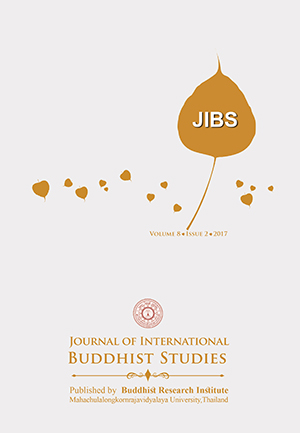NEW MODELS OF BUDDHIST SOCIAL WORK IN CAMBODIA
Keywords:
Buddhist approaches to social work, Dimensions of engaged Buddhist NGOs, new models of Buddhist social work for CambodiaAbstract
This article examines the new transformation of Engaged Buddhism in social work. It gives an understanding about the models of socially engaged Buddhist NGOs within the wider context of contemporary civil society. It suggests that engaged Buddhist organizations bring many assets to social work because they have physical space, leadership, volunteers, and material resources and they are able to mobilize people around to function both spiritual and physical needs. Engaged Buddhist organization is a phenomenon that has grown steadily in Cambodia. Through three case examples, this paper attempts to ingrate their practices into new models of Buddhist social work. In this process, the engaged Buddhists can seek to understand the key principles of Buddhism that are of direct relevance to contemporary issues. It explains different dimensions of perspective and participation by engaged Buddhist NOGs. They construct the boundaries between missions and development work. Yet, they remain primary service providers in many development contexts. They make complex political decisions about fundraising and resource allocation, and these choices are affected by their efforts to balance between religious identity and strategic goals. There are three models I have suggested for Buddhist social work in Cambodia: first, recreation model is as to socialize the roles of Buddhist social work beyond formerly identified cultural boundary of practicing Buddhism in society. Second, reform model is an alternative modern Buddhist social work to perform in the middle way within Buddhist tradition vis-à-vis modernity. Finally, revision model is a modification in line with a traditionalist and conservative to practice within identified culture and tradition. These models are flexible in response to different contexts that identity of particular path of engaged Buddhism being empowered properly to take action in social work duty.
References
Buddhism for Social Development Action. (2015). Annual Report. Kampong Cham: Thorn Vandong.
Bunly Soeung & Sung Yong Lee. (2017). The revitalisation of Buddhist peace activism in post-war Cambodia, Conflict, Security & Development, 17(2), 141-161,DOI:10.1080/14678802.2017. 1300356.
Bestsy, L. Wisner. (2011). Exploring the Lived Religion of Buddhists: Integrating Concepts from Social Work and Religious Studies, Journal of Religion & Spirituality in Social Work: Social Thought, 30,385–404, 2011, DOI: 10.1080/15426432.2011. 619903.
Chandana Chakrabarti, S. J. F. (Ed.). (2012). Morality and Spirituality in the Contemporary World. Cambridge: Cambridge Scholars Publishing.
Charles, S. P & Kenneth Kenʼichi, T. (1998). The Faces of Buddhism in America.California: University of California Press.
Christopher Q. (2003). Action Dharma: New Studies in Engaged Buddhism. London: Routledge Curzon.
Christopher W. G. (2015). Buddhist Moral Philosophy: An Introduction. London: Routledge.
David, N. K. (2004). Tibetan and Zen Buddhism in Britain: Transplantation, Development and Adaptation. New York: Routledge Curzon.
Dalai, L, Tenzin, G. (1988). Hope for the Future, In Fred Eppsteriner (Ed), The Path of Compassion: Written on Socially Engaged Buddhism. California:Parallax Press.
Jesudas M. Athyal. (2015). Religion in Southeast Asia: An Encyclopedia of Faiths and Cultures. Oxford: ABC-CLIO.
Jörn Dosch. (2012). The Role of Civil Society in Cambodia’s Peace-building Process, Asian Survey, 52(6),1067-1088 Published by: University of California Press.
John Frame. (2016). The social construction of success among leaders of faith-based and secular NGOs in Cambodia: Examining the role of faith, Journal of Religion & Spirituality in Social Work: Social Thought, 35:4, 271-294, DOI:10.1080/15426432.2016.1229149.
Judy Ledgerwood & Kheang Un. (2003). Global concepts and local meaning: human rights and Buddhism in Cambodia, Journal of Human Rights, 2(4), 531-549, DOI:10.1080/1475483032000137129.
Phil, H. (2013). Adaptation and Developments in Western Buddhism: Socially Engaged Buddhism. New York: Bloomsbury Publication Plc.
______. (2015). The Sociological Implications for Contemporary Buddhism in the United Kingdom: Socially Engaged Buddhism, a Case Study. Derby: University of Derby.
Gail, P, K arsten, S, R ichard, O. (2000). The Philosophical Quest: A Cross- Cultural Reader.Boston: McGraw-Hill.
Gary, S. (1988). Buddhism and the Possibilities of a Planetary Culture, In Fred Eppsteriner (Ed), The Path of Compassion: Written on Socially Engaged Buddhism. California: Parallax Press.
Karma, L, T. (2004). Buddhist Women and Social Justice: Ideals, Challenges, and Achievements. New York: State University of New York Press.
King, S. B. (2009). Socially Engaged Buddhism. Honolulu: University of Hawia’i Press.
Ken J. (2003). The New Social Face of Buddhism: A Call to Action. Boston: Wisdom Publication.
_____. (1988). Buddhism and Social Action, In Fred Eppsteriner (Ed), The Path of Compassion: Written on Socially Engaged Buddhism. California: Parallax Press.
Kotler, A. (Ed.). (1996). Engaged Buddhist Reader: Ten Years of Engaged Buddhist. Publishing California: Parallax Press.
Putnam, R. D. (2000). Bowling Alone: The Collapse and Revival of American Community. Simon and Schuster. New York.
Pye, M. (1978). Skillful Means: A Concept in Mahāyāna Buddhism. London:Duckworth.
Hanna, H, Ute, H, Mark, T, Vladimir & T, Koen, W. (2017). Buddhist Modernities: Re-inventing Tradition in the Globalizing Modern World. London: Routledge.
Hans Küng. (2002). Tracing The Way: Spiritual Dimensions of the World Religions. New York: Continuum Press.
Harvey, P. (2000). An Introduction to Buddhist Ethics. Cambridge: Cambridge University Press.
Helmut K. Anheier, Rengina A. List. (2005). A Dictionary of Civil Society, Philanthropyand the Third Sector. New York: Routledge.Lee.
W. B, Randall, L. N, Emily, T. (2006). Introduction to the World’s Major Religions. Londdon: Greenwood Press.
Lisa Krueger-Franke, “Cambodia: How the Life and Hope Association is helping to overcome the country’s poverty”, Accessed 2 Jun, 2017. http://thecircular.org/cambodia-poverty-in-backpackers- paradise/
Thich, N. H. (1988). Please Call Me by My True Names, In Fred Eppsteriner (Ed), The Path of Compassion: Written on Socially Engaged Buddhism.California: Parallax Press.
Todd, L, Gary, D. (2017).Teaching Buddhism: New Insights on Understanding and Presenting the Traditions. Oxford: Oxford University Press.
Queen, C. S. (1996). Introduction: the Shapes and Sources Engaged Buddhism. Albany: New York Press.







